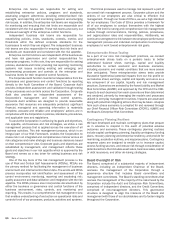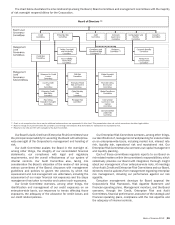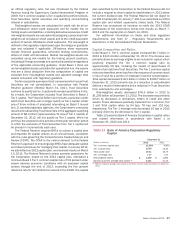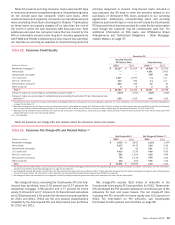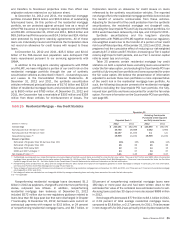Bank of America 2012 Annual Report Download - page 76
Download and view the complete annual report
Please find page 76 of the 2012 Bank of America annual report below. You can navigate through the pages in the report by either clicking on the pages listed below, or by using the keyword search tool below to find specific information within the annual report.74 Bank of America 2012
Prior to 2010, we participated in the FDIC’s Temporary Liquidity
Guarantee Program (TLGP), which allowed us to issue senior
unsecured debt guaranteed by the FDIC in return for a fee based
on the amount and maturity of the debt. At December 31, 2012,
there were no outstanding borrowings under the TLGP and we no
longer issue debt under this program. At December 31, 2011, we
had $23.9 billion outstanding and all of the debt issued under the
TLGP matured by June 30, 2012.
Contingency Planning
We maintain contingency funding plans that outline our potential
responses to liquidity stress events at various levels of severity.
These policies and plans are based on stress scenarios and
include potential funding strategies and communication and
notification procedures that we would implement in the event we
experienced stressed liquidity conditions. We periodically review
and test the contingency funding plans to validate efficacy and
assess readiness.
Our U.S. bank subsidiaries can access contingency funding
through the Federal Reserve Discount Window. Certain non-U.S.
subsidiaries have access to central bank facilities in the
jurisdictions in which they operate. While we do not rely on these
sources in our liquidity modeling, we maintain the policies,
procedures and governance processes that would enable us to
access these sources if necessary.
Credit Ratings
Our borrowing costs and ability to raise funds are impacted by our
credit ratings. In addition, credit ratings may be important to
customers or counterparties when we compete in certain markets
and when we seek to engage in certain transactions, including
OTC derivatives. Thus, it is our objective to maintain high-quality
credit ratings.
Credit ratings and outlooks are opinions expressed by rating
agencies on our creditworthiness and that of our obligations or
securities, including long-term debt, short-term borrowings,
preferred stock and other securities, including asset
securitizations. Our credit ratings are subject to ongoing review by
the rating agencies which consider a number of factors, including
our own financial strength, performance, prospects and operations
as well as factors not under our control. The rating agencies could
make adjustments to our ratings at any time and they provide no
assurances that they will maintain our ratings at current levels.
Other factors that influence our credit ratings include changes
to the rating agencies’ methodologies for our industry or certain
security types, the rating agencies’ assessment of the general
operating environment for financial services companies, our
mortgage exposures, our relative positions in the markets in which
we compete, reputation, liquidity position, diversity of funding
sources, funding costs, the level and volatility of earnings,
corporate governance and risk management policies, capital
position, capital management practices, and current or future
regulatory and legislative initiatives.
On December 20, 2012, Standard & Poor’s Ratings Services
(S&P) published a full credit analysis report on the Corporation,
leaving the credit ratings for the company and its subsidiaries
unchanged as of that date. On October 10, 2012, Fitch Ratings
(Fitch) announced the results of its periodic review of its ratings
for 12 large, complex securities trading and universal banks,
including the Corporation. As part of this action, Fitch affirmed the
Corporation’s credit ratings. On June 21, 2012, Moody’s Investors
Service Inc. (Moody’s) completed its previously-announced review
for possible downgrade of financial institutions with global capital
markets operations, downgrading the ratings of 15 banks and
securities firms, including our ratings. The Corporation’s long-term
debt rating and BANA’s long-term and short-term debt ratings were
downgraded one notch as part of this action. The Moody’s
downgrade has not had a material impact on our financial
condition, results of operations or liquidity. Each of the three major
rating agencies, Moody’s, S&P and Fitch, downgraded the ratings
for the Corporation and its rated subsidiaries in late 2011.
Currently, the Corporation’s long-term/short-term senior debt
ratings and outlooks expressed by the rating agencies are as
follows: Baa2/P-2 (negative) by Moody’s, A-/A-2 (negative) by S&P,
and A/F1 (stable) by Fitch. BANA’s long-term/short-term senior
debt ratings and outlooks are as follows: A3/P-2 (stable) by
Moody’s, A/A-1 (negative) by S&P, and A/F1 (stable) by Fitch. The
credit ratings of Merrill Lynch from the three major credit rating
agencies are the same as those of the Corporation. The major
credit rating agencies have indicated that the primary drivers of
Merrill Lynch’s credit ratings are the Corporation’s credit ratings.
MLPF&S’s long-term/short-term senior debt ratings and outlooks
are A/A-1 (negative) by S&P and A/F1 (stable) by Fitch. Merrill
Lynch International’s long-term/short-term senior debt rating is A/
A-1 (negative) by S&P.
The major rating agencies have each indicated that, as a
systemically important financial institution, our credit ratings
currently reflect their expectation that, if necessary, we would
receive significant support from the U.S. government, and that
they will continue to assess such support in the context of
sovereign financial strength and regulatory and legislative
developments.
A further reduction in certain of our credit ratings or the ratings
of certain asset-backed securitizations may have a material
adverse effect on our liquidity, potential loss of access to credit
markets, the related cost of funds, our businesses and on certain
trading revenues, particularly in those businesses where
counterparty creditworthiness is critical. In addition, under the
terms of certain OTC derivative contracts and other trading
agreements, in the event of further downgrades of our or our rated
subsidiaries’ credit ratings, the counterparties to those
agreements may require us to provide additional collateral, or to
terminate these contracts or agreements, which could cause us
to sustain losses and/or adversely impact our liquidity. If the short-
term credit ratings of our parent company, bank or broker/dealer
subsidiaries were downgraded by one or more levels, the potential
loss of access to short-term funding sources such as repo
financing and the effect on our incremental cost of funds could be
material.
At December 31, 2012, if the rating agencies had downgraded
their long-term senior debt ratings for the Corporation or certain
subsidiaries by one incremental notch, the amount of additional
collateral contractually required by derivative contracts and other
trading agreements would have been approximately $3.3 billion
comprised of $2.9 billion for BANA and $418 million for Merrill
Lynch and certain of its subsidiaries. If the agencies had
downgraded their long-term senior debt ratings for these entities
by a second incremental notch, approximately $4.4 billion in
additional incremental collateral comprised of $455 million for
BANA and $4.0 billion for Merrill Lynch and certain of its
subsidiaries would have been required.


